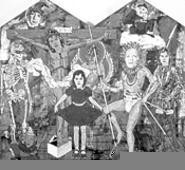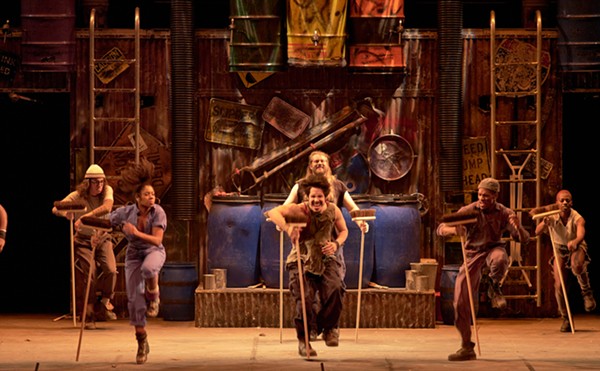Its a little like Bette Midler meets Kristin Scott Thomas.
That disparity makes the Cleveland Center for Contemporary Art show click and turns it into an amusing tour de force of two very different sensibilities dedicated to idea-driven conceptual art. To appreciate it, one must take a bit of time at the exhibit. Given better-known New York artist Hammonds flash and immediate accessibility, viewers may lack the patience to appreciate Cleveland Institute of Art professor Thomsons precisely worked canvases. However, its apparent that both are doing the same thing: having fun creating a satiric commentary on themselves and the rest of us.
Hammond makes pop-art collages on canvas and wood with graphic images copied from old published prints and illustrations. She limits herself to the same 276 images; this frees her mind and helps her to forget the rules, she says. Here, she plays with 44 titles (no poems, just the titles) commissioned from New York poet John Ashbery -- hence the name of her exhibit, The John Ashbery Collaboration, 1993-2001. As Ashbery writes in the catalog, Hammonds works resemble a museum of unsettling treats . . . cool, multicolored, cruel, dainty, hair-raisingly funny. Hammonds is a magical world, surreal and full of distortion. For example, there are two giant footprints hanging on the wall with the caption Sore Models. One big foot is red, the other blue, and each has an all-seeing eye as well as hands doing magic tricks, an image of Hammond as jester, and so many other bizarre objects painted upon it that theres no wonder why they are sore, given so much to bare/bear.
Another large flat canvas construction is called Bread and Butter Plate, and its center shows a womans vanity table with mechanical devices creating decorated hands, busts, and assorted symbols. The palpable whimsy that shines from this piece doesnt detract from the artists wry self-assessment. Hammond admits that art is her bread and butter and so must be produced from elements that make her as self-absorbed as a woman sitting at her dressing table.
One of the coolest -- and funniest-shaped -- works satirically alludes to religion, with its two triangular-topped panels resembling a diptych associated with Gothic religious art. Wonderful You II shows the artists face stuck on nine different figures ranging from St. Nick to Joan of Arc to Jesus on the cross. Its as if shes saying, I have to be everything to everyone, then laughing at her absurd presumption. Its pop art with a punch -- and a personal, poignant one at that.
Only one piece in Hammonds exhibit fails. Lobby Card is a cluster of black-and-white squares attached to each other. Each square contains a silhouette of one of her graphic figures. Its assortment of birds, magic tricks, hands, feet, and icons must be meaningful to Hammond, but its blocky and roughly finished.
Depending on the same set of fairly stock Victorian-era illustrations, Hammonds works are no demonstrations of painterly virtuosity. Overall, though, they show a delightful imagination, frisking about and commenting unreservedly on lifes foibles.
While Thomson is also having fun, her Correspondences seems less laughingly satiric. It also gives new meaning to run-on sentences (those grammatical imperfections persistently combated by English teachers and the Grammar Police). In her work, the physical appearance of words matters greatly. She presses them into double duty by using them both to convey information and to represent sounds fixed on canvas.
The suggestion that shes hidden a secret message tantalizes some viewers, making them stand so close, their noses almost touch the canvas. If she has, the messages are cryptic ones. On Summary, an oil and wax on canvas, its easy to make out lurkinginthehallway and afterwardswelaypinkandhot, even though the words are confused and tangled, partially obscured by layers of thickly applied shades of white and brown. In Play Back, scrutiny reveals that the light yellow and green letters repeat footinmouth horizontally across the whole 40-by-40-inch canvas. The letters (about a half-inch tall) seem stenciled, as they do in other works, so their shape is uniform. These pieces reflect an alphabetical minimalism and, as such, succeed both as abstract and conceptual works. Sometimes, Thomson turns alphabet characters abstract, emphasizing with heavy brushstrokes one line of a letter, subordinating clarity to shape. Forerunner, a large and striking orange-and-yellow creation, blends bold ovals and vertical lines that, while they suggest letters, are also flags. Curator Kristin Chambers notes that the painting began as a memory of a day the artist spent in Barcelona, when it was replete with red flags celebrating a national holiday.
Whats valuable about both womens works is their self-deprecating sense of play. Thomson reduces speech to a blathering, frozen-in-paint canvas and puts it neatly on the wall. Hammonds works expand speech and symbol to stretch out and threaten to overwhelm the gallery. Possibly the real reason that these artists shared exhibition space had to do with mundane scheduling concerns at the CCCA, but seeing them together is a real trip -- and worth one, too.












